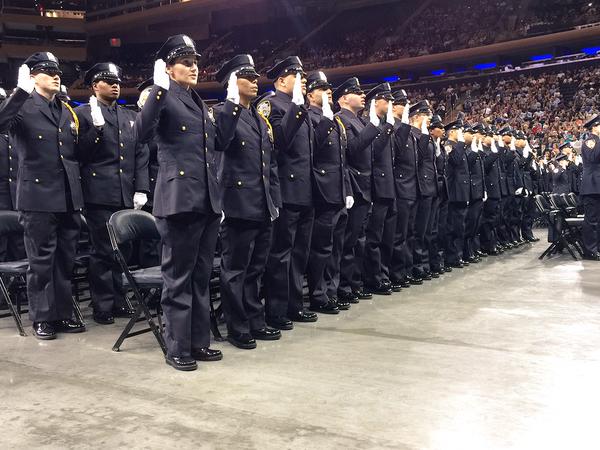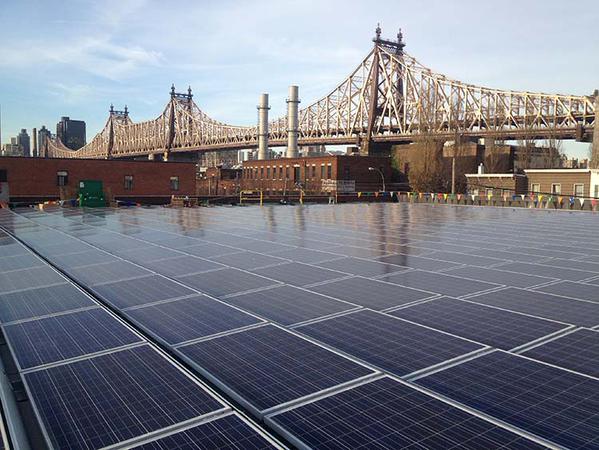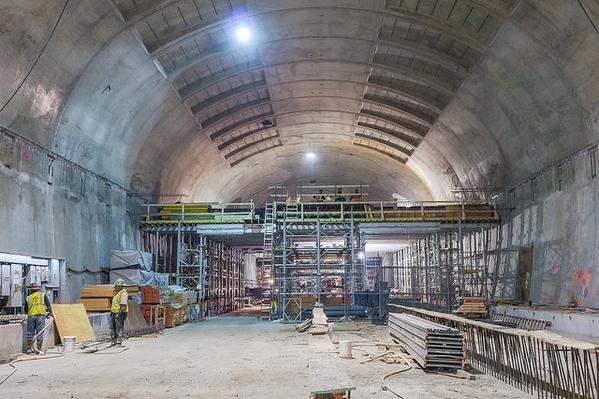New York Should Act to Protect Our Constitutional Rights

New NYPD officers take their oath (photo; @NYPDnews)
Watching cases of police brutality over the past year, I've recalled my own interactions with the police and those of young people like Keeshan Harley. At the age of 20, Keeshan, a Bushwick resident, has already been targeted and profiled many dozens of times by the NYPD through stop-and-frisk and other discriminatory tactics of broken windows policing. Keeshan once told me that the worst part of being subject to these police practices was "being put on display in front of my entire community. When the elders watch from their windowsills with no context of why I am being stopped, I can't help but think that I am being judged in their eyes as well."
Though Keeshan often feels frustrated by the continuous abuses he endures – as he should – I myself can't help to think about how lucky he is to survive those injustices. Akai Gurley, Eric Garner, Ramarley Graham, Mike Brown, Tamir Rice, Jessie Hernandez, Rekia Boyd, Walter Scott, Freddie Gray, and many others weren't as lucky.
Police accountability and transparency issues have finally taken center stage nationally—and it's about time. The history of incidents like these is long and painful, and the daily transgressions that those who look like Keeshan face are equally painful. Debates have sprung up across this country around what, or who, is to blame. What is certain is that the systemic lack of timely and meaningful accountability, and a lack of even basic transparency, is at the root of problems with policing.
Late last year, President Obama established the President's Task Force on 21st Century Policing, consisting of police commissioners, law enforcement experts and community stakeholders, including me. After we heard directly from impacted communities across the nation, the Task Force released a report full of recommendations. Task Force members had the incredible opportunity to acknowledge and urgently confront some serious problems with policing in America.
Ultimately, the next critical step is for state and local elected officials across the nation to demonstrate leadership by actually adopting reforms to substantively tackle issues plaguing our communities.
New York City is in a unique position to demonstrate national leadership in responding to this crisis - there are ongoing robust conversations about many of our recommendations that even preceded the Task Force's report.
In New York, City Council Members Antonio Reynoso and Ritchie Torres have introduced, and many other members have sponsored, a legislative package called the Right to Know Act. It mirrors Task Force recommendations that call for requiring police officers to 1) identify themselves and explain their reason for subjecting a person to law enforcement activity and 2) explain a civilian's Constitutional right to refuse a search when no legal basis exists for it except consent, and securing proof of consent when a person agrees.
These are basic common sense requirements that can begin to help change the fundamental nature of how communities are being treated by police on a daily basis. They will provide transparency and mutual understanding of people's basic rights for encounters where a clear power imbalance exists that too often leads to an unnecessary escalation of tension.
By passing the Right to Know Act, the New York City Council can show other cities and localities how to respond by advancing the transparency and protection of fundamental rights that's so sorely lacking in everyday interactions between civilians - like Keeshan - and police.
The current system is failing to protect our communities. We must fix that, and the first step is passing 'Right to Know' into law this year.
***
José López is the Organizing Director at Make the Road New York, New York's largest grassroots immigrant organization. Follow their work: @maketheroadny
New York City Can Shine with Solar Power

Solar panels (photo: @NYGovCuomo)
Cities are economic centers, engines of commerce and trade. Cities are also cultural centers, for everything from fashion and food to art and architecture. Now, thanks to a nationwide solar energy boom, cities are increasingly becoming centers for energy production, and New York City is no exception.
A new Environment New York Research and Policy Center report, Shining Cities: Harnessing the Benefits of Solar Energy in America, found that New York City ranks ninth in the nation for solar power installations. According to researchers who examined solar installations in 70 major American cities nationwide, New York City had enough solar panels online at the end of last year to power more than 6,300 homes.
Solar energy is transforming the way we view energy in America, as people convert their homes and businesses from passive energy consumers to active energy producers. And cities like New York, as centers of population and energy consumption, are taking the logical lead in this energy revolution.
Solar power makes sense for cities. From improving urban air quality and resiliency to power disruption to creating local jobs, solar carries real benefits for cities. And with the price of the average solar PV panel having dropped more than 60 percent since the third quarter of 2010, solar is now accessible to more New York City residents than ever before.
Cities across the country are wielding many different policies as tools to expand solar development. The city of Denver, for instance, has cut cost and time required to acquire solar energy permits. New York City has partnered with its local investor-owned utility to create designated "Solar Empowerment Zones" where solar energy can be most beneficial.
On Monday, Governor Cuomo acknowledged the important role of solar energy in accomplishing his ambitious plan to curb New York's carbon emissions by 40 percent by 2030. And right now, the New York Public Service Commission (PSC) is considering establishing a program, called Community Net Metering, to allow expanded access to clean energy. Following through on Governor Cuomo's commitment to expand access to renewable energy, the PSC is working to establish an innovative program that would empower low-income families, renters, and millions of other New Yorkers to choose solar. The program would allow energy customers to subscribe to a local renewable energy project and receive a utility bill credit for their portion of the energy produced.
Cities can most effectively promote solar power when city, state, and utility policies come together. That means we need state leaders to continue the policies that allow solar energy to shine.
With the cost of solar going down and concern about global warming going up, solar power is growing rapidly in New York City and across the state. By building on the progress already made, New York City can continue to be a center of solar growth in the state and an example for other cities to follow.
***
Heather Leibowitz, Esq. is the Director of Environment New York, a statewide environmental advocacy organization. New York City Council Member Donovan Richards represents the 31st Council District, in Queens.
Proposed Select Bus Service in Queens Could Jeopardize Phase 2 of 2nd Avenue Subway

Construction of the 2nd Avenue Subway (photo: Philip Plotch)
The proposed Select Bus Service (SBS) on Woodhaven and Cross Bay Boulevard scheduled for completion in 2018 is not like any other that we have seen in these parts. According to the New York City Department of Transportation (DOT), it is "bigger and bolder." It is also much more expensive. While other SBS routes have cost between $10 million and $20 million for installation, the proposed SBS route in Queens would cost a minimum of $231 million and could cost many millions more after all the necessary engineering studies are completed.
Why so expensive? We don't know. Neither the MTA nor DOT has explained why the original projected cost of $20 million suddenly rose tenfold after community meetings and workshops were held when switching from SBS to Bus Rapid Transit (BRT). The distinctions are numerous, but DOT has muddied the waters by using both terms interchangeably.
DOT currently is short of the funding necessary for project completion. The intention as stated before a City Council hearing last fall is to spend as much federal funding as could be obtained, perhaps beginning the project as BRT and completing it as SBS. That is where the Second Avenue Subway comes in. The two projects are in competition for the same federal funds under the "New Starts" program.
During the 1970s when costs started to escalate, the MTA proposed splitting the Second Avenue project into two phases postponing work that had already been started on the Lower East Side. The powerful (and now recently disgraced) Assembly Member Sheldon Silver protested, resulting in postponement of the entire project for decades. When work was finally resumed, costs had increased so much that the project had to be split into four phases with numerous delays to Phase 1, now scheduled for completion next year. Phase 2 funding would extend the project from 96th to 125th Street and is uncertain with a $15 billion shortfall in the MTA capital program and the governor missing in action.
Therefore, if the SBS route is constructed in Queens as currently envisioned, the next phase of the Second Avenue Subway could be delayed, but that is not all. Most likely this SBS route would mean the nearby parallel abandoned Rockaway Beach Line would never be reactivated as the same powerful groups who seek to turn it into parkland support SBS on Woodhaven. What's more, this obvious alternative was not included in the study of the SBS line, which was a forgone conclusion before the first community meeting was held where it was merely presented as "one alternative."
Numerous questions have been asked by community members, which have not been answered. Not only is the initial cost prohibitive, but each SBS route, of which there are now seven, costs between $2 and $4 million a year more to operate than existing local and limited services.
This is mainly due to the enforcement required to ensure fares are being paid and for maintenance of new offboard equipment these routes require. Yet ridership on these routes mostly continue to decline as does bus ridership on the rest of the bus system with the exception of routes in the Bronx. Paid ridership on the B44 SBS in Brooklyn declined by 4.4 percent during the past year, a metric possibly explained by increased fare evasion.
The problems and disadvantages with these SBS routes are too numerous to fully mention here. However, if you attend any of the DOT presentations you would think that SBS is a panacea with no disadvantages. But rather than first recognizing and attempting to solve these problems, the city is moving full steam ahead to create 13 new SBS routes before the end of Mayor de Blasio's term.
The basic premise is "trust us." Neither traffic nor transit modeling data which supposedly justify the need for these routes has been released while safety problems in the Woodhaven corridor have been greatly exaggerated.
SBS buses operate no more reliably than existing routes and still often bunch two or three buses at a time. Exclusive bus lanes at all times and prohibition of an additional 23 left turning movements and elimination of left turn lanes on Woodhaven and Cross Bay will tie existing traffic into knots, while minimally improving bus service for some and making it more inconvenient for others by the removal of some bus stops.
All SBS routes with the exception of one have had an initial first year assessment. That is because ridership initially increased on those routes, sometimes by as much as ten percent. The MTA is using that statistic to justify new routes and is ignoring the more recent SBS bus ridership decline. Ignoring it so much that they still have not and may never release a first year assessment for the B44 SBS due to the fear of jeopardizing future SBS routes. After all, how would they explain a 4.4 percent reduction in bus ridership, which is more than twice the borough average decline, when SBS is supposed to be the city's panacea for improving mass transit?
***
Allan Rosen is a former director of Bus Planning for MTA New York City Transit and is now retired and blogs for SheepsheadBites.com




